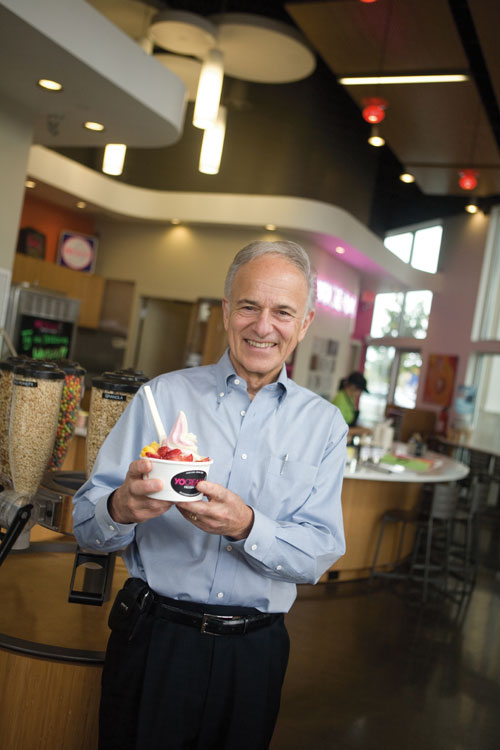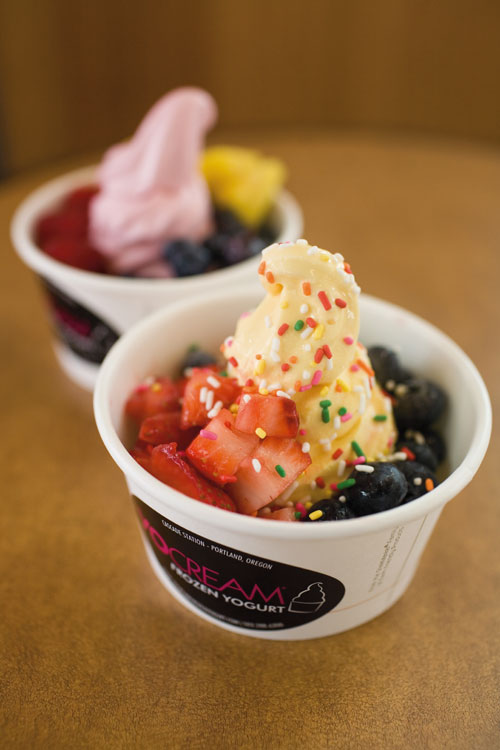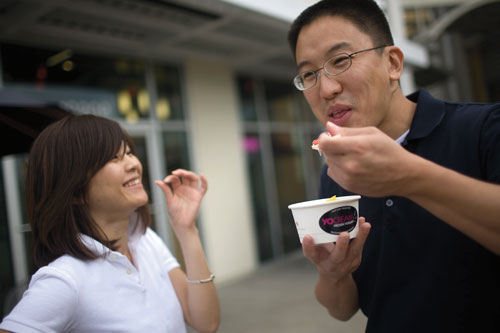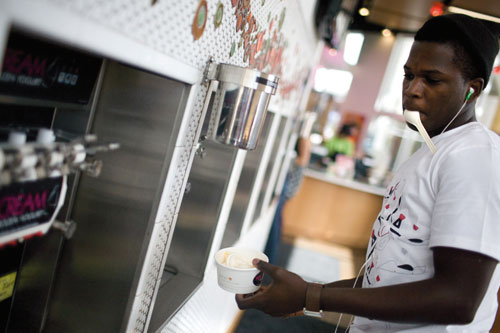 When cheerfully decorated fro-yo shops boomed again in the 2000s, YoCream was the only manufacturer ready to respond to the sudden demand. YoCream is now a $42 million company with clients as large as Sysco, Costco and Jack in the Box.
When cheerfully decorated fro-yo shops boomed again in the 2000s, YoCream was the only manufacturer ready to respond to the sudden demand. YoCream is now a $42 million company with clients as large as Sysco, Costco and Jack in the Box.
 |
JOHN HANNA, CEO |
John Hanna visits the YoCream International yogurt shop on Cascades Parkway on weekends to get a cup of Original Tart, banter with the manager, introduce himself to customers as YoCream’s CEO and ask if they’re having a good time. The 69-year-old self-identified “Portland boy” is as delighted by his customers as they are by his yogurt; he marvels that jocks and military servicemen line up for the stuff along with high school girls and moms on the way back from the gym. “When we first started this frozen yogurt thing, the slogan was ‘real men don’t eat yogurt,’” he says. “Now you go into our YoCream showroom here and there are men of all ages! The guys are enjoying it!”
In the yogurt shop, Hanna is buoyant and gregarious; in the conference room, he’s deliberate and prone to long pauses. He’s an accountant by training; YoCream was a “side investment” that took over his life in 1976 after the company’s first yogurt shop in Seattle broke even in five weeks. The frozen yogurt craze that inspired Hanna and his two brothers to found YoCream inspired competitors, but most went bankrupt or shifted their attention to other products after the trend died. Hanna stuck with frozen yogurt — true frozen yogurt, which has live cultures of beneficial bacteria called probiotics — and pushed for more flavors. When cheerfully decorated fro-yo shops boomed again in the 2000s, YoCream was the only manufacturer ready to respond to the sudden demand, he says.
YoCream is now a $42 million company with clients as large as Sysco, Costco and Jack in the Box. It just completed a $4 million expansion — on the heels of a $7.5 million expansion completed in 2007 — that doubled capacity at its plant in Portland. Hanna expects the interest in frozen yogurt to keep building as more people learn about it, and YoCream is already considering a second plant on the East Coast. Demand is rising internationally, too; Hanna went to Japan last month to discuss the Japanese and Chinese markets with a prospective distributor. YoCream, which is traded on the Pink Sheets, just posted its 13th consecutive quarter of sales growth in August.
The 32-year-old company had its awkward growth stages: an early transition from franchisor to manufacturer, an IPO in 1987, delisting after Sarbanes-Oxley in 2006, and diversification into frozen beverages after a year-long internal debate. But it’s flourished rapidly with the yogurt resurgence. “We’re responding to this growth without really a hiccup,” Hanna says, referring to the trusted management team he consults on every matter, an echo of the days when he and his brothers ruled the company by consensus.
 |
 |
 |
A black-and-white picture of the CEO as a young boy, with his brothers, shirtless and grinning, hangs on Hanna’s office wall. It’s mounted with the Ecclesiastes quote, “And if one prevail against him, two shall withstand him; and a threefold cord is not easily broken.” One brother is retired; the other is on YoCream’s board of directors. In 2002, Hanna invited his CFO and the top managers from each department to have a bigger say in YoCream’s governance. The buck stops with Hanna, but he works through every decision with the team. They meet in a first-floor conference room equipped with a blank flip chart and a supply of water. “We draw ideas from all our people. Then we huddle, the seven of us, in this room. We may spend hours here if it’s a significant issue,” Hanna says. “What emerges is a direction, and it’s usually by consensus, but I’ll ultimately have to make the decision.”
Outside advisers and the board of directors were leery of the new structure. “They said, ‘That can’t work, you need a pyramid, blah blah blah,’” Hanna says. But the structure proved effective and refreshing. “The right team was on the bus,” he says. The six senior managers have non-hierarchical titles, roughly the same compensation, and get equal bonuses based on communal goals. The sales department also adopted communal bonuses.
The company is so democratic that Hanna can’t remember who had the idea for its latest innovation, High Culture Frozen Yogurt. Released in June, it contains a strain of bacteria proven to aid digestion. High Culture has 1 billion Lactobacillus acidophilus NCFM cultures per serving, 100 times what is needed to earn the Live & Active Cultures seal from the National Yogurt Association. Hanna is banking on the increasing public awareness of probiotics, which pop up more and more in his conversations with customers in yogurt shops.
To Hanna, High Culture Frozen Yogurt is a smart investment and a social good: Yogurt is healthy, yogurt shops are happy places and all this is profitable. He prefers Original Tart, no toppings, because it reminds him of the yogurt his mom cooked on the stove when he was a kid. He has no plans to retire. “I’m having fun,” he says. “My health is good. I eat a lot of yogurt.”


